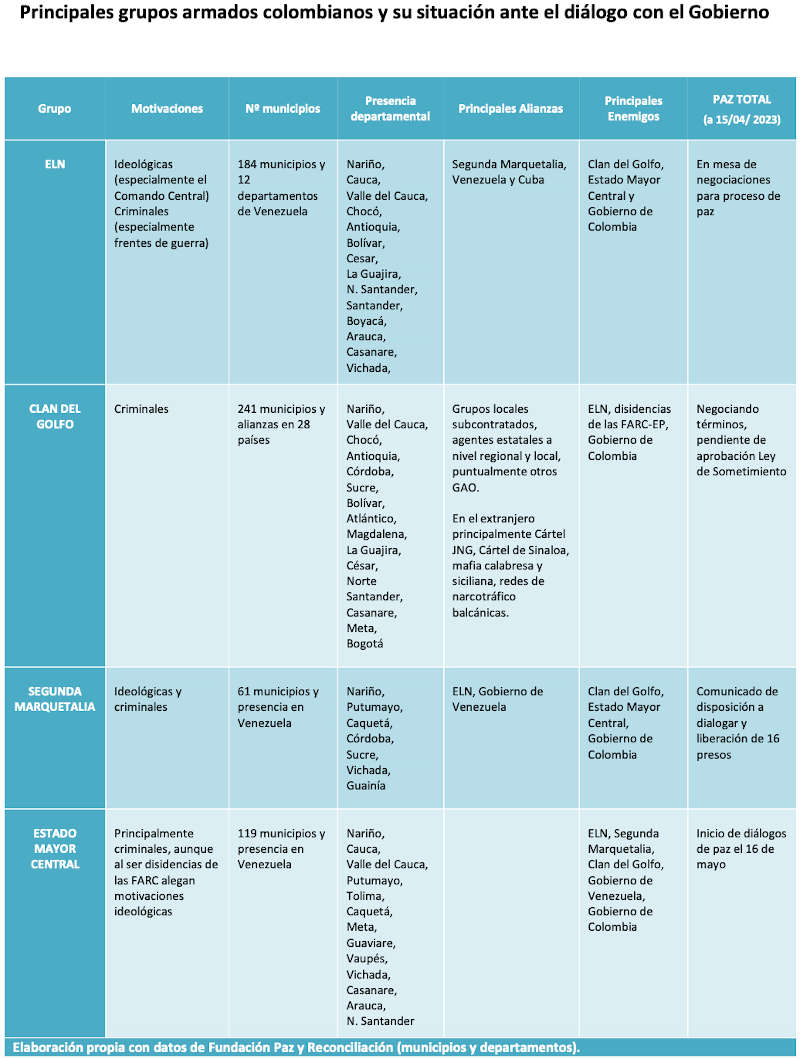In the picture
ELN propaganda image taken from its web page.
report AMERICAN REGIONAL SECURITY, SRA 2023 /PDF version from article
° After taking office in August 2022, the Colombian president launched an attempt to agreement with all armed groups, both political and criminal.
° Petro's haste in announcing a general ceasefire, on New Year's Day 2023, met with the ELN's warning that the process requires time.
° The fragmentation of the clans and the dissidences, as well as their illicit businesses that they sometimes cover for ideological purposes, pose a challenge that can overcome Petro.
On November 3, 2022, the Colombian Senate approved Law No. 181 of 2022, also known as the Total Peace Law, which allows the Government of Gustavo Petro to negotiate peace agreements with political Organized Armed Groups (GAO) and submissions to justice with criminal GAO. In order to reach agreements with criminal groups, the Submission Law is still pending approval, which provides for reduced sentences of between 6 and 8 years if the members of these groups surrender, collaborate with justice and make reparations to their victims. They would also have 4 years of probation to carry out these actions and the reductions would be annulled in case of failure to comply with any of the conditions. To date, 26 GAOs have already expressed their interest in participating in the process. statement their interest in participating in the process, being priority for the Government the ELN, the Clan del Golfo, the dissidents and deserters of the Peace agreement with the FARC-EP, and some local urban groups.
ELN
The ELN is a guerrilla group that began its activity in 1964. This group is characterized by its federated structure, led by a Central Command (CoCe) composed mostly of elders living in exile and five fronts that carry out armed actions in the territory. While the members of the CoCe have a lot of seniority in the organization and are the guardians of ideological motivations, the fronts are formed by a younger generation that grew up with the coca business and prioritizes pragmatism and the regional status of their Front. Following the 2016 Havana agreement with the FARC-EP, the ELN has undergone a phase of expansion and as of today is particularly strong in the Departments of Arauca, Norte Santander (especially the coca-growing region of Catatumbo) and Chocó. It also has a presence in 12 Departments in Venezuela where it allegedly collaborates with the Venezuelan armed forces to control mining and confront other armed groups. Its presence is mostly rural, although it has also committed attacks in large cities.
The ELN is the priority of Petro's peace diary , due to its political character, its size and previous attempts to negotiate with the guerrillas. Negotiations with the ELN will have Norway, Venezuela, Cuba, Brazil, Mexico and Chile as guarantor countries. The first cycle negotiations took place in Caracas between November and December focusing on bringing positions closer and achieving a ceasefire and humanitarian relief. A few weeks later, the Government announced a bilateral ceasefire with several OAGs, among them the ELN, but this was denied by the ELN itself, causing the first crisis in the negotiations. The second cycle was held in Mexico between February and March. It established the peacediary composed of the following six points: participation of society, democracy, transformations, victims, end of the conflict and implementation plan.
However, on March 29, an ELN attack killed nine army soldiers in Norte Santander, followed by an ELN attack on the Western Front criticizing the talks, causing a second crisis in the negotiations. statement by the Western Front criticizing the talks, causing the second crisis in the negotiations. The president urgently convened the government negotiating table and is expected to push for a bilateral ceasefire and ceasefire. This will be the topic to be discussed at the third cycle negotiations to be held in May in Cuba.
The structural nature of the ELN is the major challenge of the negotiations as the CoCe will have to mediate between its own will and that of each of the fronts to reach agreements with the Government. For now the fronts have little incentive to demobilize either because of their bi-national nature, the fear of other GAOs occupying their zones of influence or their deep presence in their zones of control.


